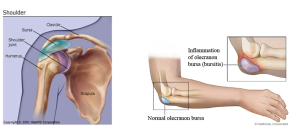By: Dr. Rami Rustum – August, 2016
Bursitis is the inflammation or irritation of the bursa. The bursa is a sac filled with lubricating fluid, located between tissues such as bone, muscle, tendons, and skin, that decreases rubbing, friction, and irritation.
The most common causes of bursitis are repetitive motions or positions that irritate the bursa around a joint. Examples include:
• Throwing a baseball or lifting something over your head repeatedly
• Leaning on your elbows for long periods
• Extensive kneeling for tasks such as laying carpet or scrubbing floors
• Prolonged sitting, particularly on hard surfaces
Other causes include injury or trauma to the affected area, inflammatory arthritis such as rheumatoid arthritis, gout, and infection.
The most common symptom of bursitis is pain. The pain may build up gradually or be sudden and severe, especially if calcium deposits are present. Severe loss of motion in the shoulder — called “adhesive capsulitis” or frozen shoulder — can also result from the immobility and pain associated with shoulder bursitis.
If you have bursitis, the affected joint may:
• Feel achy or stiff
• Hurt more when you move it or press on it
• Look swollen and red
Bursitis is more common in adults, especially in those over 40 years of age.
Doctors can often diagnose bursitis based on a medical history and physical exam. If further testing is needed, you might undergo:
• Imaging tests. X-ray images can’t positively establish the diagnosis of bursitis, but they can help to exclude other causes of your discomfort. Ultrasound or MRI may be used if your bursitis can’t easily be diagnosed by a physical exam alone.
• Lab tests. Your doctor may perform blood tests or an analysis of fluid from the inflamed bursa to pinpoint the cause of your joint inflammation and pain.
Treatment:
– Nonsurgical Treatment
The initial treatment for hip bursitis does not involve surgery. Many people with hip bursitis can experience relief with simple lifestyle changes, including:
• Activity modification. Avoid the activities that worsen symptoms.
• Non-steroidal anti-inflammatory drugs (NSAIDs). Ibuprofen, naproxen, piroxicam, celecoxib, and others, may relieve pain and control inflammation. Use NSAIDs cautiously and for limited periods. Talk with your doctor about the NSAIDs you use. NSAIDs may have adverse side effects if you have certain medical conditions or take certain medications.
• Assistive devices. Use of a walking cane or crutches for a week or more when needed.
• Physical therapy. Your doctor may prescribe exercises to increase hip strength and flexibility. You may do these exercises on your own, or a physical therapist may teach you how to stretch your hip muscles and use other treatments such as rolling therapy (massage), ice, heat, or ultrasound.
• Steroid injection. Injection of a corticosteroid along with a local anesthetic may also be helpful in relieving symptoms of hip bursitis. This is a simple and effective treatment that can be done in the doctor’s office. It involves a single injection into the bursa. The injection may provide temporary (months) or permanent relief. If pain and inflammation return, another injection or two, given a few months apart, may be needed. It is important to limit the number of injections, as prolonged corticosteroid injections may damage the surrounding tissues.
• Surgical Treatment
Surgery is rarely needed for hip bursitis. If the bursa remains inflamed and painful after all nonsurgical treatments have been tried, your doctor may recommend surgical removal of the bursa. Removal of the bursa does not hurt the hip, and the hip can function normally without it.
A newer technique that is gaining popularity is arthroscopic removal of the bursa. In this technique, the bursa is removed through a small (1/4-inch) incision over the hip. A small camera, or arthroscope, is placed in a second incision so the doctor can guide miniature surgical instruments and cut out the bursa. This surgery is less invasive, and recovery is quicker and less painful.
Both types of surgeries are done on an outpatient (same-day) basis, so an overnight stay in the hospital is not usually necessary. Early studies show arthroscopic removal of the bursa to be quite effective, but this is still being studied.


